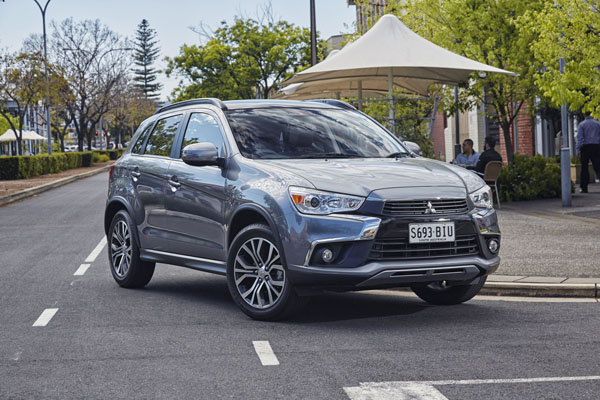
Mitsubishi ASX is the smallest, but biggest-selling, of the Japanese carmaker’s Australian 4WD/SUV range. On sale since early 2010 it’s been a major success for Mitsubishi, consistently sitting among the top three or four sellers in the highly-competitive compact SUV market segment and just pipped at the post by Mazda CX-3 for top spot in 2016.
The appeal of vehicles such as ASX lies in their functionality with a tall, square design that provides a higher than normal driving position and practical rear storage space.
The choice of the name ASX caused a few chuckles initially because, although it’s an abbreviation for Active Sports Crossover, it’s also the one used for the Australian Stock Exchange. The ASX name is used in Europe while in the United States it is sold as Outlander Sport and in Asian markets as the RVR.
Like most of its competitors ASX is aimed more at on-road use than tackling the Aussie bush, although it does come with the option of all-wheel drive and so can be used on dirt roads, forest trails and the like. We’d recommend taking up the full-size spare wheel if you’re looking at off-road driving.
Two equipment levels are offered, badged LS and XLS both with either 2WD petrol or AWD diesel.
Mitsubishi ASX was given an upgrade in late 2016 with a number of styling and functionality changes. The most obvious of the exterior tweaks is a new grille that uses the Mitsubishi Dynamic Shield that has previously been used on ASX’s larger siblings, Outlander and Pajero Sport. There are also new black and chrome finishes to the front bumper and grille as well as a new shark fin antenna. Combination style front fog lamps replace the previous daytime running lamps.
As before the XLS comes with a panoramic sunroof.
All models get 18-inch alloy wheels.
INTERIOR
There’s good interior space with plenty of rear leg and headroom and a large, easily accessible boot that caters for 393 litres with the rear seat back in place, and up to 1193 litres with them folded.
Extra seat base bolstering has been added to the rear seats for improved comfort. The LS gets a new high-grade fabric seat trim with red stitching while the switch for the heated front seats has been moved to the instrument panel. LS has key-in-ignition start while XLS has keyless entry and start / stop.
The steering wheel is both height and reach adjustable.
ENGINES
Engine capacity and outputs are unchanged from the previous model with the choice of 2.0-litre petrol with outputs of 110 kW at 6000 rpm and 197 Nm at 4200; and 2.2-litre turbo-diesel peaking at 110 kW at 3500 revs and 360 Nm at 1500 rpm.
The lower-specced LS petrol variant gets the choice between five-speed manual and continuously variable automatic transmission. The XLS petrol only comes with the CVT. Both LS and XLS diesels get a torque convertor six-speed automatic.
SAFETY
Safety features on all ASX models include ABS brakes with electronic brakeforce distribution and brake assist; stability and traction control; seven airbags (front, side, curtain and driver’s knee); rear parking sensors; reversing camera; IsoFix rear child seat anchor points; and hill start assist.
INFOTAINMENT
The LS model uses a 6.1-inch full colour touchscreen for its information display while the XLS steps up to the Mitsubishi Multi Communications System (MMCS) with a 7.0-inch screen and two extra speakers with satellite navigation added to its features. Other standard features include Bluetooth phone and audio; digital radio; USB socket; and voice control. The XLS also has an SD card input.
DRIVING
Entry and exit don’t require excessive bending and stooping. The front seats are comfortable and reasonably supportive despite quite low bolsters. Dashboard controls, knobs and the touchscreen are logically placed and easy to use. Exterior vision is good at all angles.
Our test car was the manual XLS 2WD petrol. It’s sluggish initially but sharp enough once it gains momentum although, as mentioned, peak power isn’t reached until a high 6000 rpm. We’ve yet to test the diesel but would expect a noticeable improvement in take-off torque.
A five-speed manual gearbox is unusual nowadays but the absence of an extra gear didn’t affect cruising comfort. Gear changes are slick and smooth.
Typical of its genre there’s not a great deal of driving fun to be had but it feels safe and predicable provided that it’s driven as it should be.
Fuel consumption is listed at 7.7 litres per 100 km in the LS manual, we averaged in the mid-8s.
SUMMING UP
ASX comes with the standard Mitsubishi five-year warranty although, disappointingly, the distance component is now only 100,000 km – down from the 130,000 km given on pre-2015 models.
Pricing and style together practicality and limited off-road ability are proving an excellent combination for Mitsubishi ASX as its sales success demonstrates. So it’s well worth adding to that long shopping list (which Toyota has now belatedly joined) if you’re in the market for a compact SUV.
AT A GLANCE
MODEL RANGE
LS 2.0-litre petrol 2WD five-door wagon: $25,000 (manual), $27,000 (CVT)
LS 2.2-litre diesel 4WD five-door wagon: $32,500 (CVT)
XLS 2.0-litre petrol 2WD five-door wagon: $31,500 (CVT)
XLS 2.2-litre diesel 4WD five-door wagon: $37,000 (CVT)
Note: These prices do not include government or dealer delivery charges. Contact your local Mitsubishi dealer for driveaway prices.
SPECIFICATIONS (Mitsubishi ASX XLS 2WD 2.0-litre five-door wagon)
ENGINE:
Capacity: 1.998 litres
Configuration: Four cylinders in line
Maximum Power: 110 kW @ 6000 rpm
Maximum Torque: 197 Nm @ 4200 rpm
Fuel Type: Petrol 91ROM
Combined Fuel Cycle (ADR 81/02): 7.4 L/100km
CO2 Emissions: 176 g/km
DRIVELINE:
Continuously variable transmission
DIMENSIONS, WEIGHT AND CAPACITIES:
Length: 4295 mm
Wheelbase: 2670 mm
Width: 1770 mm
Height: 1625 mm
Turning Circle: 10.6 metres
Kerb Mass: 1375 kg
Fuel Tank Capacity: 63 litres
BRAKES:
Front: Ventilated disc
Rear: Solid disc
STANDARD WARRANTY:
Five years / 100,000 km